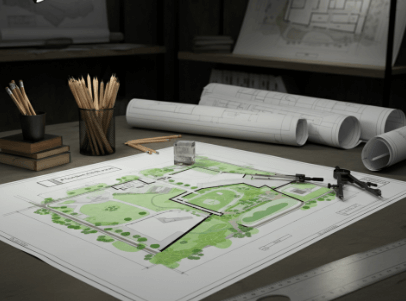What is a Plot Plan in Real Estate? A plot plan, also known as a site plan, is a detailed drawing of a piece of land that details land features, boundaries, and structures. It acts as a roadmap for spatial organization, showing proposed and existing improvements like buildings, parking areas, driveways, and stormwater management. Understanding the intricacies of land use and boundaries is crucial when venturing into homeownership or property development. One essential tool in this field is the plot plan. But exactly, “What is a Plot Plan in Real Estate?”
This blog seeks to demystify the concept of a plot plan, providing readers with a deep dive into its importance, how it is created, and why it’s a critical element in real estate transactions and property development. Whether buying your first home, planning a new construction, or just curious about real estate practices, understanding “What is a Plot Plan in Real Estate?” is an invaluable part of your property toolkit.
Steve Daria and Joleigh, renowned real estate investors, emphasize that a detailed plot plan is crucial in evaluating potential property investments. They consider it an indispensable tool for navigating the competitive real estate market, which requires making well-informed decisions.
The Legal and Technical Premises of a Plot Plan
Compared to a simple survey, understanding what is a plot plan in real estate is more comprehensive, aiming to locate and describe the configuration of a property, including its property lines and often neighboring plots.
It’s utilized during zoning applications and permits for construction and can offer crucial insight into municipal codes and restrictions affecting the property.
Why is it Crucial for Real Estate Development and Transactions?
Understanding what is a plot plan in Real Estate and its role extends to nearly every facet of real estate activity.
For developers, it is a tool for space management and development process planning.
For home buyers, understanding the plot plan can be essential for future modifications and compliance with property codes.

Creating a Plot Plan for Your Property
Understanding what is a plot plan in Real Estate is crucial for developing a property or looking to sell.
Here are the steps to create a comprehensive plot plan for your property:
Engage a Professional Land Surveyor
This is not a DIY project. You will need the expertise of a professional land surveyor who understands local zoning laws and land development regulations.
They will visit the site and take accurate measurements that ensure the plot plan reflects the actual property dimensions.
Gather Existing Documents
Any legal or technical documents associated with the property, such as a deed or old surveys, can provide valuable information.
These will assist the surveyor in locating and confirming property lines and other features pertinent to the plot plan.
Draw to Scale and Include All Necessary Elements
The plot plan should be drawn to scale, typically using 1 inch for every 10, 20, or 30 feet, depending on the property size.
It must include every structure, setback, driveway setback, and other vital aspect of the land per the surveyor’s direction and local regulations.
Comply with Zoning and Land Use Regulations
The plot plan must comply with the area’s zoning and land use regulations. It can also ensure that any proposed site work or construction aligns with the local laws.
This is critical to avoid fines, legal issues, and frustrations down the road.
Get An Offer Today, Sell In A Matter Of Days
Understanding the Key Components of a Plot Plan
Here’s what each element on a plot plan stands for and why it is critical to grasp their significance.
Property Lines and Dimensions
The property lines on a plot plan are the legal boundaries of your land. Once aware of them, you can avoid encroachments (building over the property line), a common legal issue in real estate.
Dimensions will tell you how much space you have to work with.
Existing and Proposed Structures
Knowing where your existing structures stand about property lines can help you discern if there is space for additions, what setbacks regulations require, and potential compliance issues.
For developers, showcasing proposed structures previews the completed project and its efficiency.

Easements and Rights-of-Way
Easements grant non-owners access to the property for specific purposes, such as utility services.
They can impact the property’s current or future use. The plot plan will detail the location and type of easements, and they are often a point of negotiation or restriction in real estate deals.
Topographic Information
Understanding the lay of the land is vital during development. A plot plan can include contour lines and spot elevations, which provide insight into the land’s slope and are critical in drainage and grading plans.
Utilizing a Plot Plan in Your Real Estate Endeavors
With a comprehensive plot plan, there are numerous ways to leverage this document for success in real estate endeavors.
Listing a Property with a Detailed Plot Plan
For sellers looking to attract developers or individuals with specific land needs, a detailed plot plan can provide the necessary information to make an informed decision about the property’s fit.
Navigating Zoning and Permit Processes
Whether building a new structure or changing an existing one, a plot plan is crucial for securing permits.
It showcases compliance with zoning laws and is required documentation in the application process.
Facilitating Transparent Real Estate Transactions
Transparency is vital in real estate transactions. A plot plan can preemptively address potential disputes and alleviate the buyer’s concerns by visually representing the property and its features.
Supporting the Development and Design Process
From landscaping to architecture, a plot plan is the foundation for design. It ensures the layout of structures and overall usage of the land adhere to regulatory and environmental considerations.
Going Digital with Plot Plans
In the digital age, plot plans’ role and functionality have evolved. They are now part of an integrated real estate management and development approach, transitioning from a static document to a dynamic data set.
Geographic Information Systems (GIS) Integration
Plot plans are now often integrated into GIS systems, which allows for a combination of geographic and property-specific data.
GIS mapping can provide layers of information such as soil types, environmental considerations, and the location of other regional assets.
Interactive and 3D Representations
Through advanced software, plot plans can now be transformed into interactive models that provide a realistic visual of the land and its features, aiding potential buyers in understanding its potential.
Pitfalls and Best Practices Around Plot Plans
Even with the best intentions, mishaps can occur.
Here are some potential pitfalls and best practices to consider when planning plots.
Accuracy and Up-to-Date Information
Regularly updating the plot plan with any changes on the property is crucial, ensuring it remains a reliable resource.
Understanding and Negotiating Easements
There might be instances where easements limit property use or are not documented.
Acknowledging existing easements on the plot plan and being able to negotiate their terms is a best practice.
Cross-referencing with Other Property Documents
To ensure the plot plan is as comprehensive as possible, cross-reference it with other property documents to compare information, such as surveys, title reports, and environmental assessments.
Professional Review
Always pay attention to the value of a professional review. A surveyor, real estate attorney, or accredited land consultant can provide a second opinion on the accuracy and presentation of the plot plan, helping you avoid potential pitfalls.
Conclusion
Now that we have an overview of what is a plot plan in Real Estate, it’s crucial to remember that a plot plan is an invaluable asset in the world of real estate. It is a visual testimony to a property’s potential, history, and legal status.
Whether you are a developer eyeing a new project or a homeowner looking to add an addition, understanding the significance of a plot plan is not just beneficial – it’s crucial. A precise and comprehensive plot plan can be your silent yet salient companion for every real estate process step, from due diligence to the final walk-through.
In the age of information and transparency, ensure you leverage this tool to its fullest extent. Your plot plan is more than just lines and shapes on a page – it’s a strategic advantage in a competitive and intricate real estate market.
**NOTICE: Please note that the content presented in this post is intended solely for informational and educational purposes. It should not be construed as legal or financial advice or relied upon as a replacement for consultation with a qualified attorney or CPA. For specific guidance on legal or financial matters, readers are encouraged to seek professional assistance from an attorney, CPA, or other appropriate professional regarding the subject matter.

